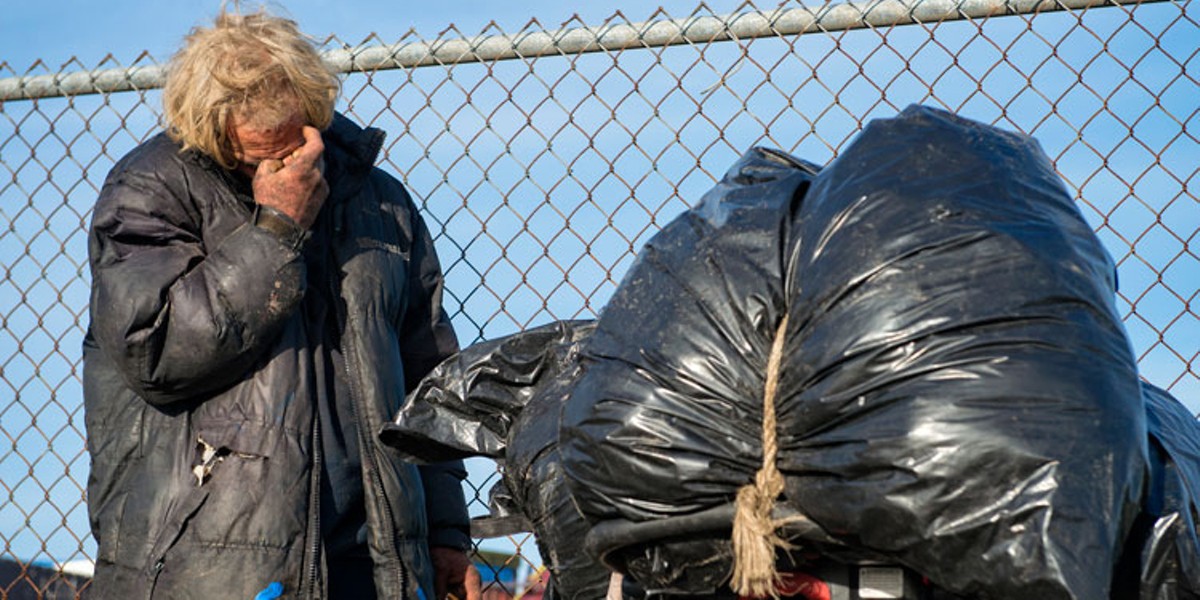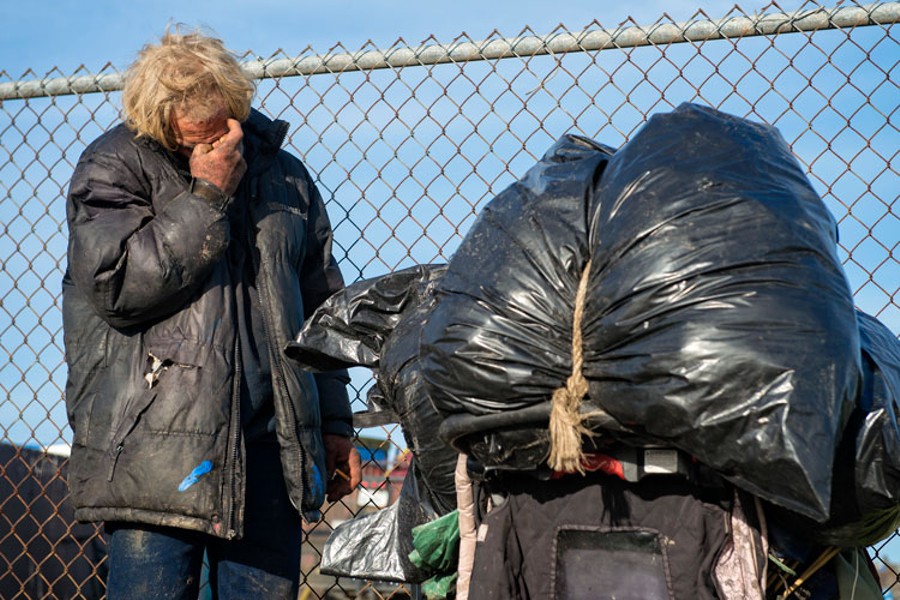With time and options dwindling, it now appears the Humboldt Housing and Homeless Coalition will zero in on finding land where people can safely camp or stay in a large tent. The coalition, made up of representatives from a broad spectrum of local organizations and nonprofits, including county employees, shelter operators, advocacy groups and local healthcare providers, has met weekly since Nov. 2 to collaborate on establishing a six-month, 24-7 emergency shelter. (See "The Impossible Possible," Nov. 9.) A potential influx of refugees from recent fires in Sonoma, Napa and Mendocino counties and the conversion of the Multiple Assistance Center from transitional housing to a drug treatment facility have made the issue even more pressing.
The Nov. 13 meeting kicked off at 10 a.m. with reports from coalition members who had attempted, and failed, to find a building to convert into a shelter. The owner of the now-empty Kmart building at Eureka's south end "doesn't even want to talk about it," reported Eureka Housing Projects Manager Melinda Petersen. Another potential warehouse is slated to house a cannabis company. The empty pool building at College of the Redwoods is not seismically safe. Other buildings were lined with asbestos, in neighborhoods that would probably not tolerate a shelter, not accessible by public transportation or simply owned by landlords skittish about their property being used to shelter the chronically homeless, the addicted, the mentally ill, the people, as Sally Hewitt, senior program manager for the Humboldt County Department of Health and Human Services and co-chair of the HHHC, has said, most in need. At 10:40 a.m., Hewitt broke in to summarize the dilemma.
"Where are we so far?" she asked briskly. "We don't have a building. We have some ideas for if we had land. A lot of ideas about what could be done with land. Should we look for land?"
This suggestion was greeted with a barrage of research from members of the nonprofit Affordable Homeless Housing Alternatives, which has been advocating for a tiny house village or sanctioned camp in Humboldt County since 2014. At the Nov. 27 meeting, AHHA co-founder Nezzie Wade brought a thick folder of paperwork that included zoning classifications for various tracts of county land and pictures of a county building near Humboldt Hill that has gone unused for several years. AHHA has promoted a model like Opportunity Village, near Eugene, Oregon, where residents live in tiny homes with a communal kitchen and other facilities, paying $1 a night. Several coalition members discussed research that shows more municipalities are acknowledging demand for shelter is outpacing available affordable housing, meaning that "Housing First" strategies might simply not be viable, and alternative or creative options, such as allowing people to camp, might be best.
Hewitt passed around a folder with information about inflatable tents, which carry an estimated price tag of $20,822, over a third of the $60,000 DHHS has allocated for the project. Wade added her group has investigated using yurts, which could cost as little as $7,000. Robert Ward, an administrative analyst for DHHS, brought up a recent program in San Diego that saw 700 homeless people formerly camping on the streets sheltered in large tents. The decision was prompted, in part, by an outbreak of hepatitis A, which has ravaged that city's homeless population, killing 20 and sickening hundreds more. The San Diego Housing Commission allocated $6.5 million from its permanent housing fund to staff the shelters.
"They look like [Federal Emergency Management Agency] camps," Ward told the coalition. "They're very organized, very clean."
"That's probably the only way the community would accept it," said Lynette Mullen, homeless services manager for the Eureka Police Department.
"Why don't we do that?" a coalition member murmured.
"We don't have enough money," came another murmur.
Community member Janelle Egger said her analysis of available shelter beds versus estimates of total homeless people in Humboldt County revealed there is a gap of around 300 people who couldn't be accommodated in shelters like the Eureka Rescue Mission, meaning the roughly 40 people the HHHC estimates an emergency shelter could hold would leave out many more currently sleeping rough.
"If we start small and show the community that nothing horrible happens, it may open the door," said Mullen.
Coalition members agreed to continue searching for a building or land, reaching out to realtors groups and putting advertisements on Craigslist. In the meantime, several gaps in services remain for those seeking housing. There is little available for women and families. There is almost nothing for unaccompanied children under the age of 18, who often couch surf if they're not in foster care. Maura Eastman, with the Redwood Community Action Agency, says 18-to 24-year-olds are the most in need. They often don't meet criteria for help from county programs, such as veteran's assistance or disability services, and are vulnerable populations in emergency shelters and homeless camps. Housing children accompanied by their families in the same shelter as sex offender registrants is problematic. Hewitt agreed the records of all sex offenders would have to be examined. A person on the registry for public urination, for example, might be eligible for entry while someone convicted of a violent crime or crimes against children would not.
"If we were optimistic, we would start talking about intake," said Hewitt. Coalition members agreed it would be best to have clients referred from agencies, rather than giving out a location or address for people to turn up at, which might alarm neighbors. Each agency could be allocated a set number of beds and work with the clients on a one-to-one basis to assess who is most in need, rather than using rigid guidelines to decide who would be sheltered. While much of the San Diego project's budget was allocated to staffing, the Humboldt version would operate more as a "one stop shop" for current clients of DHHS and other agencies, a place where it could reliably access the population rather than searching through the bushes. With such a limited budget, much of the logistics and support might fall to volunteers or nonprofit employees.
"Roger [McCort] was tapped for management," said Hewitt, referring to the Salvation Army lieutenant, "but I'm not sure what he's willing to do."
"Whatever needs to be done, as long as I have help," said McCort. The Salvation Army was prepared to offer a shelter the previous winter but its contract with Silvercrest Residence prohibited using the Tydd Street location for that purpose.
McCort also provided the coalition with a template of an operations plan. While the Salvation Army has been criticized in the past for its theological stances on the LGBTQ population, the plan's manifesto delineates that "sexual orientation is generally not a relevant issue in low-barrier shelter settings, as the required standard of conduct is independent of that factor."
While the coalition continues to search for a location, Hewitt said the money allocated for the project, earmarked for public health efforts, will not expire if not used by the end of the year. If the shelter project ultimately fails, that money may be cycled back into current DHHS stop-gap efforts to house the most vulnerable — the elderly, the medically frail — in local motels.
Editor's note: This story was edited from its original version to reflect the fact that Janelle Egger is not a member of AHHA, but a community member that has worked with that organization in the past.Linda Stansberry is a staff writer at the Journal. Reach her at 442-1400, extension 317, or [email protected]. Follow her on Twitter @LCStansberry.



Comments (6)
Showing 1-6 of 6